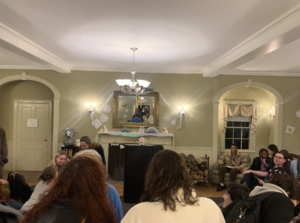To create a film about writing is nearly impossible. It lacks the color, the stroke, the erotic curl of a wrist in motion as it glazes a canvas or a sketchbook. There are more films depicting art than there are those depicting writing, and further, there are even more films about cooking (appropriately so, for food lends itself to perfect stylistic euphoria as the textures of cinema rise like steam from a plate.)
But to write about writing is another discussion. The frustration and pain, the romantic indulgence of writing itself remain to this day as a purely internal artistic agony. In his book Out of Sheer Rage: Wrestling with D.H. Lawrence, Geoff Dyer shifts the narrative on writing in ways that are more realistic and grounded. With a style of digressive musing, he laments upon the act of writing not as a romantic endeavor, but a pursuit of immersive catharsis, an intoxicating closeness to experience and life that is as compelling in feeling as the book itself.
Though the book projects its subject as being D.H. Lawrence, this is, in reality, far from the truth; while he acts as the uniting thread stitching the book together, it is Dyer himself who is most vocal in the text. The project began as an elusive series of indecisions, as Dyer struggled to decide whether to write a novel or an academic study of Lawrence. He leaped between the two, producing little results, lamenting his frustrations, before feebly deciding to write about Lawrence. Though one decision here is made, there are more that go untouched. After committing to writing about Lawrence, Dyer does anything but, slipping into discussions of Rilke and photography that eventually return to the main subject. What we receive is not vague, abstract research into Lawrence’s life and work, but a digressive following of Lawrence’s travels (he visits and meditates upon the locations, letters, and photos of Lawrence as he attempts to write about the man.) He searches for the place in which to plant himself that he may begin to write about Lawrence, and yet, even as he does this, he is inexplicably tied to the writer; the digression follows the trail of the man himself, a form of constructive procrastination that manifests itself in charming prose.
The experience of “studying” Lawrence becomes the book itself; far from dry academia, Dyer’s voice is both wise and humorous, charismatic and sonorous. He writes with a clearness in his voice that channels the minutiae of life into something charges, critical, thirsty. Even towels hanging over the balconies of Italian homes are more emblematic of the country itself than its flag, for they display the small glories of daily life as opposed to the dry, mediatized political symbology. The controllore stationed to direct traffic in Rome is not so much a figure of law, but a conductor guiding the flow of kinetic bodies with virtuosity. The clanky, heavy Nikon camera his partner insists upon bringing everywhere but never uses is an object containing the romantic aura of being a tourist, a symbol of experience as opposed to the captor of it (Dyer writes “I am a camera,” as he absorbs the visual and experiential nodes of his travels with the same physical trapping of a camera in his writing. The Nikon is nuanced, held, an artifice of that serene detachment associated with the traveler, the wanderer, the tourist.)
Even with the dominance of narrative guiding the book, it touches the critical academia of daily life. As he visits the homes and photos of Lawrence, Dyer gives him critical attention that is more traditional of his original pursuit. As he travels, he notes the new divisions between work and idleness. Dyer both mourns and despises his lack of a clear work life. His self-employment grants him non-escapist cultural immersion at the expense of holidays, moments of rest during the weekends, are non-existent. Though he can travel, be free and independent from an employer without the anxieties arising in rest at the anticipation of the workweek, he does not receive the settled surety of a career, the guaranteed comforts of living, a faithful separation of work and life that does itself lend one clarity (though the capitalistic discussion here leaves little room for the economic form’s inherent hegemony.)
From here, he draws the connection to Rilke, who desires that one becomes seduced by work with the same way one is by idleness, calling for a hermetically sealed devotion to labor, a discussion that, for the poet, becomes especially difficult as he tries to follow his own teachings. But Lawrence, Dyer writes, does not call for a seduction of work or idleness. Rather, his actions were always designed as forms of self-construction. Work was not done if it did not support the essence of his being, not was rest; the fluctuations of the two were reliant upon the notion of individuality, or perhaps more accurately, the action of it (an idea that can be summed up in the words “to be.”)
It is this core detail that connects Dyer’s digressive style in the book. It is organized along with the parallel pursuit of avoiding and imbued himself within D.H. Lawrence, with that core desire to simply Be. The tracings of Lawrence are present, resonant, for at times Dyer presents himself as a case study for Lawrence’s ideas. As Lawrence desires a firmness of his own experience, Dyer’s digressive travels and journeys geographically and artistically become the active pursuit “to be.” The anxiety of wrestling with D.H. Lawrence is, more so, wrestling with himself.
Dyer’s style is pure, descriptive, vivid, not in form alone, but in the quality of the ways in which his prose seeps into and permeates life itself. As he describes Italy, Greece, Rilke, San Francisco, photos, and himself, Lawrence rises as the dominant thread connecting the mise en scene of selfhood in the narrative itself. The digression is deeply personal, and yet, is delivered with a unity to Lawrence that is as intoxicating to the reader as it is rich. For instance, the simple reading of a newspaper in Italy becomes a “substitute for prayer,” a dire codification of the reader as the pursuant of divinity. The simple act of being and un-repression, the simple ideas in Dyer’s writing and Lawrence’s philosophy, are tucked not in interpreting the latter, but in the construction of his image. The avoidance of wholly studying Lawrence, the digression along with the accolades and frustrations of writing, become the writing itself. The style of the writing and the book itself then works “fractionally” to the experience of Lawrence, of standing where he stood, of gazing into his eyes in photographs. It is a jotting of experience with a profoundly electric “lightning flash” of development. The style of the book, in short, is deeply experientially, running close to the skin and within the body, snapping into life on the page. The digression is, then, deliberate execution, distraction becomes art, a purely cathartic process that, on the page, translates to a likewise emotional and enticing read with cinematic attention to the minutiae of daily life.
Digressive, emotional, humorous, pointed, wise, and confessional, Dyer’s book contains to its core, as Barthes wrote, “that which pricks me.” It is kinetic in its construction, and in its keen attention, compels us as the reader to likewise “be,” allowing the pains and joys of life to imbue our bodies with the sensational power of living for ourselves above all else. The kinetic embodiment of the form electrifies the body and soul alike as it coaxes feelings and senses from our very nerves—the non-linear stitching and disjointedness, the clear organization behind the galleria of digressive prose, is an emblem of the self in all its contradictions. To be human is to wrestle with the self, to coax the synapse from the skin, as Dyer has done in the book, for on the page (from the act of writing itself) he wrestles with himself and Lawrence alike.
The book then does what film fails to do. It captures writing and criticism not as a career-driven form of work, but as the pursuit of life. The soul is embedded in the book’s artifice. The digression that defines the book more so describes ourselves; we muscle through and confront the romantic act of being with a realistic awareness. To write about writing involves not writing at all. Writing is not the act of placing the pen on paper alone; it is likewise a tectonic topography of experience manifesting in language. Dyer’s book is a testament to this process, to the mapping of life as it relates to the creation of art, that soulful trapping of existence in a creative singularity—“to be” is to live, and in Out of Sheer Rage: Wrestling with D.H. Lawrence, we find life as itself, life as ourselves, and from the style of digressive experience, we are presented with the critical and creative framework of the nuanced, erotic, and cathartic nature of life in all its pains and joys.








It is a jotting of experience with a profoundly electric “lightning flash” of development. The style of the book is deeply experientially, running close to the skin and within the body, snapping into life on the page. This blog is interesting and helpful page. I am impress for this post. Thank you so much.